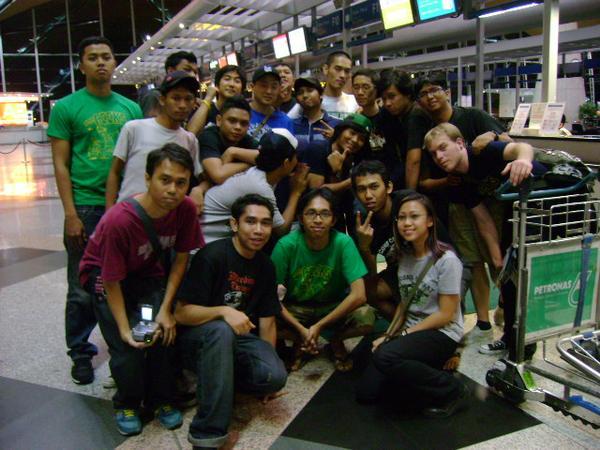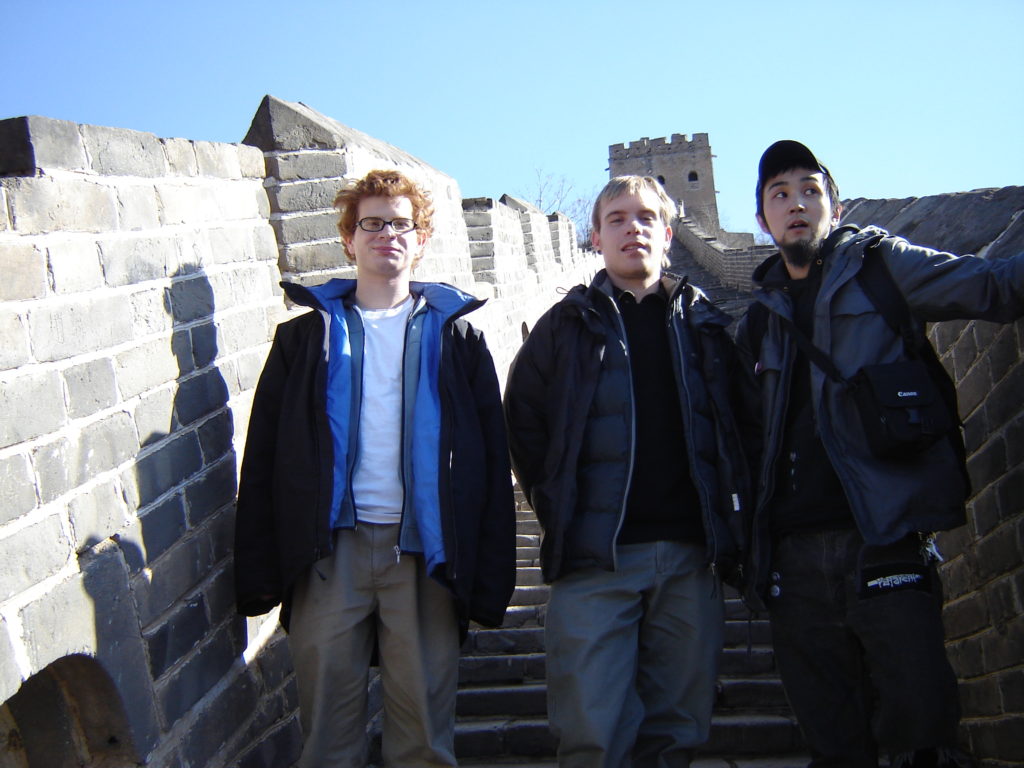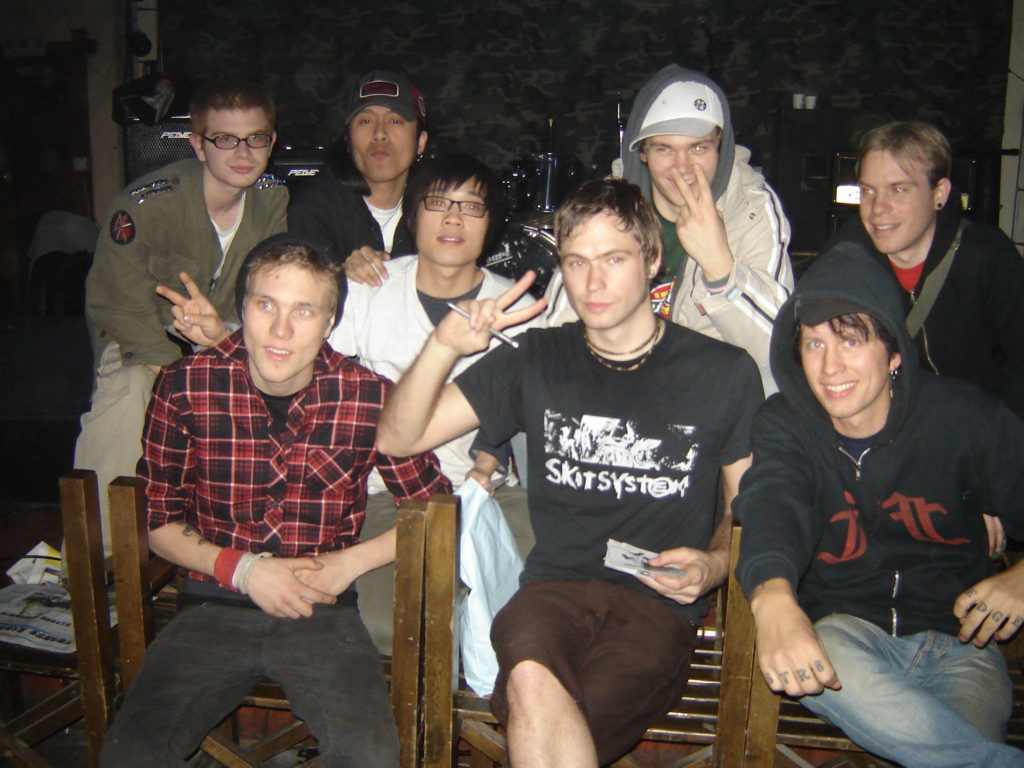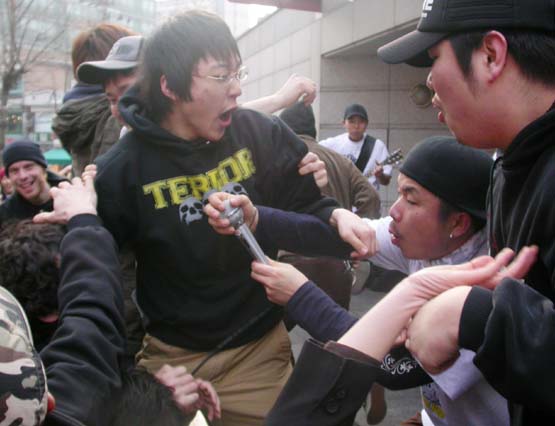The first release on Genjing Records came out before the label even existed, but it set the tone for what was to come. It formed the mold for the subsequent releases and delineated the boundaries of the label, a template that, surprisingly and unintentionally, has held for the majority of the label’s fifty-seven releases to date.
I started putting GR001 together in 2009. At the time, I was living in Beijing and playing in the hardcore-punk band Fanzui Xiangfa. The band had been together for a couple of years, and we’d recorded an initial demo in 2006. We were trying to record a follow-up, but the recording didn’t go according to plan. To tell that story, though, I’ll need to explain a bit more about the band, how it was formed, and the various accidents and chance decisions that led to creating the record label and its first paradigmatic release. I’ll start four years earlier when I was living in Korea and just beginning to explore Asia’s various punk scenes.

LOST SEOULS
Before moving to Beijing, I lived for several years in Seoul, South Korea, teaching English on a Fulbright scholarship and studying the Korean language. While there, I spent my weekend nights at the Hongdae punk club Skunk Hell, going to shows and drinking in the park with the local punks. It was a formative time for me, often being the only foreigner in the crowd and familiarizing myself with a new culture and language through the underground music scene. Despite being an outsider, I was warmly accepted by many, and some of the Korean musicians I met at that time remain close friends.
As I became more involved in the community, I moved from spectator to participant. Eventually, I joined the legendary Kangwon-do grindcore act Pulgasari for a handful of shows and a split tape with Singapore’s Fallen World. The other member of the two-piece, Gunhee, was a strident DIY punk. He stood in opposition to almost everyone else in the Korean scene. While that often created conflict and drama, he injected new influences and ideas into a scene overwhelmingly influenced by Rancid and Oi! style punk.
One of the styles that Gunhee championed was crust, and near the end of 2005, when I was preparing to leave Korea, he organized a handful of Seoul shows for the legendary Japanese peace-crusties Battle of Disarm. I had previously met their singer, Ryuji, on a trip to Tokyo several months earlier, where I visited his record store, DIY Records. So when Gunhee told me they were coming to Korea, I agreed to help out with the shows by communicating with the band and securing the venue and local Korean acts while Gunhee was traveling in Europe.
From the start, there was miscommunication, not between myself and the bands but between myself and Gunhee. One of the three Japanese bands we were planning to bring, Power of Idea, dropped out when they discovered there was only one show and not a full tour of the peninsula as Gunhee had promised. Also, Gunhee wasn’t happy about the Korean bands I had asked to play. I was already in the midst of preparing to leave Korea and barely had time to sleep; now, I was scrambling to pull together loose threads in the organization. In the end, the two bands who came over, both Battle of Disarm and Screen Out, were great people and super chill. They were eager to communicate with the local punks and to learn about the Korean scene. They played the main show at Skunk Hell and a second impromptu practice space show, which excited them as much as the club gig. Pulgasari joined one of the shows, I believe the one in the practice space, and immediately after, I moved to China.

By the time I moved to China, I had lived in Korea for over three years and felt that I needed a change. While I loved the country and had become fluent in the language, something still felt lacking. I sought a community where I could take a more active role in a country where there were jobs open to me other than just English teaching or editing. I’d previously lived in China for a year in 1999-2000 for a study abroad program at Dalian University of Foreign Languages and had heard rumors of Beijing’s nascent punk scene at the time but hadn’t been able to track it down except for a few CDs by bands like Underground Baby, Hang On The Box, and No. I kept searching, though, and while in Korea, I discovered the website Wuhanpunk.com. Eventually, I got in touch with a few kids over email, including Main Dian, the author of the Wuhan political-punk zine Chaos Zine. Mai Dian told me that punk in Wuhan was dead, but through our communication, I decided to return to China and that the place to be was Beijing.
In November 2005, I moved to Beijing with my cousin Adam, who studied with me in Dalian in 1999-2000 but subsequently moved to London for university. He flew to Seoul for the Battle of Disarm show, and then we gleefully lugged all our possessions in suitcases across town, on a train to Incheon, and from there by ferry to Dalian. It was an adventure for us and an exciting break from our previous lives. We took our time hanging out in Dalian for a week, sleeping in a friend’s bar, and enjoying the freedom of vagabonds before catching a train to Beijing. Upon arrival in Beijing, we immediately started searching for the punk scene. First, we decamped to a hotel near the musical instrument stores in Xinjiekou. Eventually, we settled on an apartment in the student area of WuDaoKou, where we’d heard that punks hung out.

It was an exciting time of exploration, discovering bands and seeing shows at venues like Old (and New) What, Nameless Highland, and, the then brand new, 13 Club. The winter was cold though, our apartment didn’t have heat (or maybe we just never figured out how to open the pipes), and we were flat broke. So soon after settling in, we fled back to Korea by ferry to find work at winter English teaching camps. What we earned in four weeks of work in Korea could support us for at least as many months in Beijing. This pattern of working winter and summer English camps in Korea and returning to live frugally in Beijing sustained me for several years. It afforded me plenty of free time in Beijing to throw into music scene-related projects with little or no income.
Korea became a familiar refuge I kept returning to through the transition. I relied heavily on my relationships there while I struggled to form new ones in China. While working at that first English camp, I learned my friends in the Korean straightedge band, The Geeks, were about to embark on their first Southeast Asian tour. It only took me one night to decide to follow them before returning to Beijing. This decision was pivotal to creating Genjing’s first release and probably for the label itself and the path of my life.

That first trip through Malaysia and Singapore opened my eyes to the vibrant DIY scenes of Southeast Asia and bands such as Second Combat, Kids on the Move, and Secret Seven. It showed me what a political DIY community could be like, and while I had encountered similar communities in the US, the Philippines, and Japan, this was my first time experiencing them as a band on tour. They were some of the most exciting DIY scenes I’d experienced, and by the time I left Kuala Lumpur for Beijing, I was already planning a way back.
At this point, I was starting to get accustomed to jumping on other people’s tours, and when I heard from my old bandmate Gunhee that he was organizing a Korea tour for the Philadelphia hardcore-punk act R.A.M.B.O. I decided to tag along. It was to take place at the end of March, and we also planned for Pulgasari to reunite for the tour and desperately needed to practice. This was the excuse Gunhee needed to visit China, so he booked himself a ferry and planned to crash on my couch. He planned to take in the sights during the day and jam in the evenings. We weren’t a very technical band, so the emphasis was more on ideas than execution. When he arrived, he told me, in his nonchalant and ear-to-the-underground way, that the guitarist from the 90s Swedish fastcore bands DS-13 and Abinanda lived in Beijing and that he had invited him to our practice.

Jonas had been living in Beijing studying Chinese for a year, but his connection to China stretched back to the early 90s. Growing up in Umea, Sweden, he was an avid collector of Kung Fu films and a practitioner of Wushu. As Jonas became increasingly interested in Chinese culture, he started studying the language. Then, in the summer of ‘98, he met Jonney, the Swedish drummer for P.K.14, who was in Umea visiting a mutual friend. It was from Jonney that Jonas learned about the Chinese punk scene and everyday life in Beijing. Jonas’ brother Dennis, singer for the Refused, was also interested in the Chinese scene. In 1999, with Jonney’s help, he became one of the first foreign artists to tour China with his band, the International Noise Conspiracy.
It took Jonas a bit longer to get to China, but he stayed in touch with Jonney, and in 2001 when he was broke and unemployed, he decided to visit him in Beijing. Jonney helped him get a fake internship at the web design company where he worked, and Jonas received money from the unemployment office in Sweden to cover the three-month internship. In reality, though Jonas just hung out, staying at Jonney’s house near Houhai and exploring Beijing and the city’s burgeoning young punk scene.

Adam and I met Jonas at the Nameless Highland bar in Beijing in December 2005. Jonas was on tour with his post-DS-13 band Insurgent Kid. At the time, I don’t think Adam and I realized that he was the guitarist for DS-13, but we were happy to hang out with anybody who could speak English. I’m not sure what Jonas thought of us, though, as he is a lifelong straightedger and, judging from the fact I remember very little of the actual show, Adam and I must have gotten pretty drunk. Fortunately, he never seemed to hold that against us.
The Pulgasari practices, in my recollection too, were pretty rough. The way I remember it, Adam and I were regularly practicing with our punk-covers-of-Johnny-Cash band Bu Hao Chi, and I booked Pulgasari into the same room after our practice. There was always a lot of drinking and joking around at Bu Hao Chi practice, and I think that spilled over to the Pulgasari practice with everyone staying on to hang out. I guess Jonas was impressed, though, or at least forgiving enough that soon after, he asked Adam and me to play in a project he was starting. This didn’t make Gunhee happy and may have contributed to the growing rift between us.

After a week or so, both Gunhee and I returned to Korea. I took a flight first to meet the band at the airport while Gunhee followed a day later by boat. The R.A.M.B.O. guys were chill. We split them up between two houses, and, as they were in the middle of an extensive Southeast Asian tour, they mostly wanted to sleep, except for the singer, who was an avid birdwatcher and had a list of native Korean birds he wanted to check off his list.
The Seoul gigs went well, including a very memorable free outside gig where the band started a circle pit that went around the block. Pulgasari performed with them for both the Seoul gigs, I believe, and then followed them to Chengju and Daejeon. It was during this tour that the rift between Gunhee and me grew. I think he felt that I wasn’t confrontational enough as he severely criticized the Korean punks for not caring about politics. At the end of the tour, the band imploded, and Gunhee disappeared from the scene while I returned to China. It wasn’t the easiest tour as I juggled the roles of tour manager for R.A.M.B.O. and conflict manager for my band. I still miss the R.A.M.B.O. guys, though, and learned from these two tours in Korea and the one in Southeast Asia how much impact DIY exchanges can have on local scenes.

Korea had been an important part of life and a place I kept returning to, but after this tour, I finally settled down and started to find a community in Beijing. After all, now I had a band in China! Next time I’ll discuss how Fanzui Xiangfa came together and our first aborted attempt to record the songs for this release.
Continue reading Part 2.
